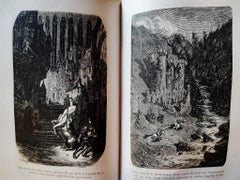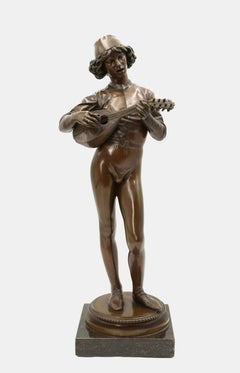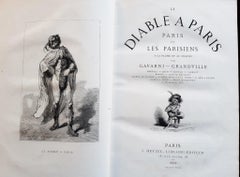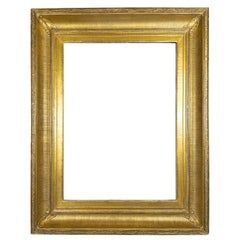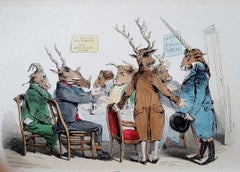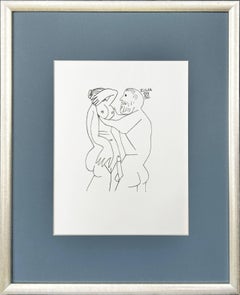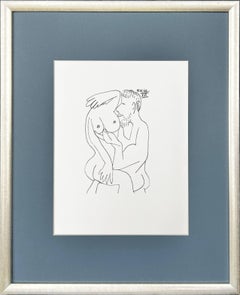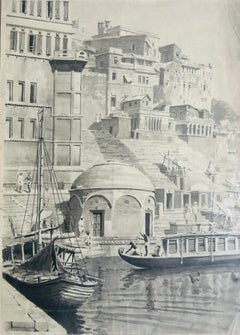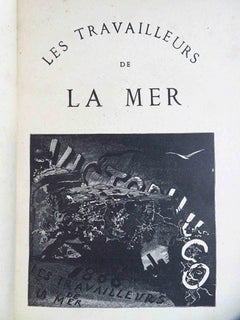1860s More Art
to
4
16
1
5
1
Overall Width
to
Overall Height
to
139
538
4,622
10,013
90
69
254
288
147
323
441
433
433
1,228
72
8
16
5
1
1
1
1
1
8
8
5
4
3
2
1
1
1
1
14
8
Period: 1860s
Les Contes Drolatiques - Rare Book Illustrated by G. Doré - 1861
By Gustave Doré
Located in Roma, IT
Les Contes Drolatiques is an original modern rare book written by Honoré de Balzac (1799 – 1850) and illustrated by Gustave Doré (Strasbourg, 1832 – 23 January 1883) in 1861.
Publis...
Category
Modern 1860s More Art
Materials
Paper, Etching
Housatonic River at Cornwall
Located in Milford, NH
A fine Connecticut river landscape by American Hudson River artist John William Casilear (1811-1893). Casilear was born in New York City, began his study with master engraver Peter M...
Category
Hudson River School 1860s More Art
Materials
Canvas, Oil
Florentine singer / - The Renaissance of the Renaissance -
By Paul Dubois
Located in Berlin, DE
Paul Dubois (1829 Nogent-sur-Seine - 1905 Paris), Florentine singer, 1865. Light brown patinated bronze with cast round plinth mounted on a square marble base (3.5 cm high). Total height 53 cm. Bronze dimensions: 49.5 cm (height) x 20 cm (length) x 10 cm (width), weight 5.6 kg. Inscribed on the plinth "P.[aul] DUBOIS", dated "1865", with the foundry's mark "F. BARBEDIENNE FONDEUR" and the signet "REDUCTION MECANIQUE A. COLLAS".
- Patina very occasionally darkened, lute with loss of one tuning peg, otherwise in excellent condition.
- The renaissance of the Renaissance -
The bronze is a precisely executed and masterfully cast contemporary reduction of Paul Dubois 155 cm tall masterpiece "Florentine Singer", which is exhibited in the Musée d'Orsay and for which the artist was awarded the Medal of Honor at the Paris Salon in 1865. The work acted as a beacon, and was followed by a plethora of depictions of juveniles.
Inspired by Donatello and Luca della Robbia, but also by painters such as Piero della Francesca, Benozzo Gozzoli, and Pinturicchio, the "Florentine Singer" is not an epigonal work that pays homage to a vanished era, but a successful attempt to draw vitality from the art of the past and thus give it new life.
The effect of vitality is the core of Italian Renaissance art theory. In order to fulfill itself as art, art had to appear like nature. This naturalism also characterizes the "Florentine Singer". The young man appears to have been taken from life, which is reinforced by the momentary nature of his action. He has just struck a now fading chord. In addition, the natural appearance is enhanced by the detailed shaping of the figurative details, such as the laces with the slightly curved leather of the shoes, the belt buckle, or the ornamentation on the body of the lute. Even the fingernails are clearly defined. Unlike the Renaissance, however, the effect of liveliness here is not based on the "discovery" of nature and the human body, but primarily on the rediscovery of the art of the Quattrocento. The liveliness of the artwork is therefore at the same time a revitalization of this art, so that we can speak of a Renaissance of the Renaissance, just as the Pre-Raphaelites in England at the same time transferred the Quattrocento to contemporary art.
Dubois takes on the most difficult of all subjects, the depiction of singing through silent sculpture. He was preceded in this by Luca della Robbia and Donatello with their pulpits of singers created in the 1430s in the Museo dell'Opera del Duomo in Florence. Compared to these works, the physiognomy of Dubois singer is far less animated, yet he also depicts singing in a convincing manner. He uses the whole body. He takes the ancient contrapposto, which was essential to Renaissance sculpture, and transforms the standing leg-playing posture into a late medieval S-swing, giving the body an elegant beauty and at the same time setting it in melodic motion. In the equally elegant finger position, the music is expressed in a much more literal way with the beating of the lute. Finally, the musicality of the sculpture culminates in the face with the mouth open to sing.
Through the act of singing, which is a great challenge to the artistic will to depict perfect beauty, the gracefulness of the classical face is not diminished, but enhanced. Starting from the face with the singing mouth and the gaze absorbed by the sounds, the inner vitality spreads, giving the bronze sculpture an intense aura, enhanced by the music. Dubois transfers the beauty of the Renaissance to the musical, sublimating the visible sculpture to the invisible of music.
He took up the challenge of transcending the Renaissance with the Renaissance, thus responding to the Querelle des Anciens et des Modernes, which arose at the end of the 17th century around the French Academy and remained virulent into the 19th century, in which antiquity was regarded either as an unattainable ideal or as a standard to be surpassed. With his work, Dubois proved that the Renaissance, which had championed the art of the ancients, could lead to a new renaissance of art.
About the artist
Paul Dubois' great-uncle was the famous French Baroque sculptor Jean-Baptiste Pigalle, in whose footsteps the talented great-nephew followed. When he debuted at the Paris Salon in 1858, he signed his work "Dubois-Pigalle". At his father's request, however, he first studied law before devoting himself to sculpture under the tutelage of François Christophe Armand Toussaint in 1856 and entering the École des Beaux-Arts in 1858. From 1859 to 1863, he lived in Rome and traveled to Naples and Florence. Inspired by Florentine art of the quattrocento, Dubois initiated a school-forming neo-Florentine style that combined the elegantly simple forms of youthful grace with a precise wealth of detail.Two purchases by the French state (“envois de Rome”) were made during his stay in Rome, which brought him recognition in Paris. After his return there, he quickly became an internationally sought-after artist.
Dubois was also active as a creator of monuments. His most famous work is the equestrian statue of Joan of Arc (1896) on the forecourt of Reims Cathedral. He was also a sought-after portraitist who produced around 50 busts and - Dubois was also a passionate painter - around 100 portraits in oil.
From 1873 to 1878 he was curator of the Museum du Luxembourg, in 1876 he became a member of the Institut de France and from 1878 to 1905 he was director of the École des Beaux-Arts.
In 1865, Dubois was awarded the Paris Salon Medal of Honor for his “Florentine Singer”. In 1867 he became Chevalier, in 1874 Officier, in 1886 Commandeur of the Légion d'honneur, which awarded Dubois the Grande Croix in 1896.
Selected Bibliography
Stole, Elmar: Paul Dubois. In: Saur. Allgemeines Künstlerlexikon, vol. 30, Munich - Leipzig 2001, pp. 677-678.
GERMAN VERSION
Paul Dubois (1829 Nogent-sur-Seine - 1905 Paris), Florentinischer Sänger, 1865. Hellbraun patinierte Bronze mit gegossener runder Plinthe auf quadratischem Marmorsockel montiert (3,5 cm Höhe). Gesamthöhe 53 cm. Maße der Bronze: 49,5 cm (Höhe) x 20 cm (Länge) x 10 cm (Breite), Gewicht 5,6 kg. Auf der Plinthe mit „P.[aul] DUBOIS“ bezeichnet, auf „1865“ datiert, mit dem Gießereistempel „F. BARBEDIENNE FONDEUR“ und dem Signet „REDUCTION MECANIQUE A. COLLAS“ versehen.
- Patina sehr vereinzelt nachgedunkelt, Laute mit Verlust eines Stimmwirbels, ansonsten ausgezeichnet erhalten.
- Die Renaissance...
Category
Realist 1860s More Art
Materials
Bronze
$4,312 Sale Price
20% Off
Le Diable à Paris - Rare Book Illustrated by Paul Gavarni - 1869
By Paul Gavarni
Located in Roma, IT
Le Diable à Paris is an original modern rare book written by Various Authors and illustrated by Paul Gavarni (1804 – 1866) and by Jean Ignace Isidore Gérard (Nancy, 1803 – Vances, 1847) in 1869.
Original First Edition.
Published by Hetzel & Cie, Paris.
Format: 4°.
The book includes 816 pages in 4 volumes.
Hundreds of lithographs (several are full page Lithographs).
Very good conditions.
Paul Gavarni (1804 – 1866) and by Jean Ignace Isidore Gérard (Nancy, 1803 – Vances, 1847). Paul Gavarni was the nom de plume of Sulpice Guillaume Chevalier (1804 – 1866), a French illustrator, born in Paris. Among his illustrated works were Les Lorettes, Les Actrices, Les Coulisses, Les Fasizionables, Les Gentilshommes bourgeois, Les Artistes, Les Débardeurs, Clichy, Les Étudiants de Paris, Les Baliverneries parisiennes, Les Plaisirs champêtres, Les Bals masqués, Le Carnaval, Les Souvenirs du carnaval, Les Souvenirs du bal Chicard, La Vie des jeunes hommes, and Les Patois de Paris. He had now ceased to be director of Les Gens du monde; but he was engaged as ordinary caricaturist of Le Charivari, and, while making the fortune of the paper, he made his own. His name was exceedingly popular, and his illustrations for books were eagerly sought for by publishers. Le Juif errant, by Eugene Sue (1843, 4 vols. 8vo), the French translation of Hoffman's tales (1843, 8 vo), the first collective edition of Balzac's works (Paris, Houssiaux, 1850, 20 vols. 8 vo), Le Diable à Paris (1844–1846, 2 vols. 4 vo), Les Français peints par eux-mêmes (1840–1843, 9 vols. 8vo), the collection of Physiologies published by Aubert in 38 vols. 18mo (1840–1842), all owed a great part of their success at the time, and are still sought for, on account of the clever and telling sketches contributed by Gavarni.
Jean Ignace Isidore Gérard (Nancy, 1803 – Vanves, 1847), generally known by the pseudonym of Jean-Jacques, J. J. Grandville or most commonly simply Grandville, was a French caricaturist. Grandville's ability for political provocation made his work much in demand. He worked in a wide variety of formats, from his first job illustrating the parlor game Old Maid, to illustrated newspaper strips of which he was a master. His illustrations for Le Diable à Paris ("The Devil In Paris"; 1844–46) were used by Walter Benjamin for his study of that city as an urban organism. One of Grandville's supreme achievements, at a time when French printing technology was ascendant, was Les Fleurs Animées, a series of images that are both poetic and satirical. But perhaps his most original contribution to the illustrated book form was Un Autre Monde, which approaches the status of pure...
Category
Modern 1860s More Art
Materials
Paper, Lithograph
1860s American Hudson River Gilt Wood Antique Frame
Located in Jacksonville, FL
1860s American Hudson River Gilt Wood Antique Frame
Frame Size: Width: 33.75″ X Height: 42.25″
Thickness: 6″
Picture Size: Width: 22.50″ X Height...
Category
1860s More Art
Materials
Wood
Les Métamorphoses du Jour - Rare Book Illustrated by J. J. Grandville - 1869
Located in Roma, IT
Les Métamorphoses du Jour is an original modern rare book written by Various Authors and illustrated by Jean Jacques Grandville (Nancy, 1803 – ...
Category
Modern 1860s More Art
Materials
Paper, Watercolor, Lithograph
Vie Privée et Publique des Animaux - Illustrations by J.J. Grandville - 1868
Located in Roma, IT
Vie Privée et Publique des Animaux is an original modern rare book engraved by Jean Jeacques Grandville (Nancy, 1803 – Vanves, 1847) and written by Various Authors in 1868.
Original...
Category
Modern 1860s More Art
Materials
Paper, Photogravure
Ancient Flyer "mazziniano" -Document of Italian" Risorgimento" - 1860s
Located in Roma, IT
Ancient flyer "mazziniano" is an original document of Italian" Risorgimento" realized in 1860 ca.
Lithograph on creamy-colored paper.
Propaganda manifesto "Italians’ struggle for ...
Category
Modern 1860s More Art
Materials
Paper
$440 Sale Price
20% Off
Ancient Flyer "Mazziniano" - Original document of Italian" Risorgimento" - 1860s
Located in Roma, IT
Ancient flyer "mazziniano" is an original document of Italian" Risorgimento" realized in 1860 ca.
Lithograph on creamy-colored paper.
Propaganda manifesto "Italians’ struggle for l...
Category
Modern 1860s More Art
Materials
Paper
Il Fischietto (The Whiste) N°1 - Original Lithographs - 1863
Located in Roma, IT
The Whistle N°1 is an original print realized in 1863 in Italy.
On the first and on the second pages are present different lithographs.
Excellent conditions, some small losses on...
Category
Modern 1860s More Art
Materials
Paper, Lithograph
19th Century Woolie Featuring Sailboat with Saint George British Flag
Located in Austin, TX
19th Century British Woolie featuring Sailboat with red St. George British Flag
Medium is Wool
Framed
In good condition
Category
Folk Art 1860s More Art
Materials
Wool
Spectacular GILDED Frame Mirror or Painting - 13 x 17 OR 12 x 16
Located in Exton, PA
Gilded frame made in a traditional style. The frame opening will accommodate a painting or mirror that is 13 x 17 inches; with the addition of a 1" liner, a standard sized 12 x 16 painting...
Category
Rococo 1860s More Art
Materials
Wood
$556 Sale Price
34% Off
19th Century Steamboat British Woolie
Located in Austin, TX
An original 19th Century Steamboat Woolie
12" x 15.5"
Medium: wool
Category
Folk Art 1860s More Art
Materials
Wool
Ancient Flyer "mazziniano" - Document of Italian" Risorgimento" - 1860s
Located in Roma, IT
Ancient flyer "mazziniano" is an original document of Italian" Risorgimento" realized in 1860 ca.
Lithograph on creamy-colored paper.
Propaganda manifesto "Italians’ struggle for l...
Category
Modern 1860s More Art
Materials
Paper
$440 Sale Price
20% Off
American 1860s Hudson River Antique Painting Gold Frame
Located in Jacksonville, FL
American 1860s Hudson River Antique Frame Antique Painting Gold Frame
Frame Size: Width: 26.50″ X Height: 22.25″
Thickness: 4″
Picture Size: Width: 2...
Category
1860s More Art
Materials
Wood
19th Century Royal Standard Coat of Arms Woolie
Located in Austin, TX
19th Century Woolie of The Royal Standard Coat of Arms
Made of Wool
Mid 19th Century created in 1867
Created by member of The British Royal Navy
Category
Folk Art 1860s More Art
Materials
Wool
"Small Dish (Sepia Color), " Ceramic created in China circa 1860
Located in Milwaukee, WI
This ceramic dish was made by an unknown Chinese artist in the 1860s. It features sepia designs on a white background. The dish has a 5 1/4" diameter.
Category
Folk Art 1860s More Art
Materials
Ceramic
H.M.S Liverpool Woolie
Located in Austin, TX
HMS Liverpool Woolie, 19th Century
Made in 1860
British, English Origin
Original frame
Category
Folk Art 1860s More Art
Materials
Wool
American 1860's Hudson River - 10 1/8 x 8 1/8
Located in Jacksonville, FL
American 1860's Hudson River School Gilt/Wood frame with fluted cove interior.
Rabbet Size: 10 1/8 x 8 1/8 in.
Sight Size: 9 5/8 x 7.5 in.
Overall Framed Size: 15.5 x 13.5 in.
(04-103)
Provenance: The Historic Period Frame Collection from the Gallery of Eli Wilner...
Category
1860s More Art
Materials
Wood
American 1860's Hudson River School - 8.75 x 7
Located in Jacksonville, FL
American 1860's Hudson River School Gilt/Wood Frame. Old label verso.
Rabbet Size: 8.75 x 7 in.
Sight Size: 7.5 x 6.25 in.
Overall Framed Size: 15.5 x 14 in.
Provenance: The Historic Period Frame Collection from the Gallery of Eli Wilner...
Category
1860s More Art
Materials
Wood
American 1860's Hudson River School - 8.75 x 7
Located in Jacksonville, FL
American 1860's Hudson River Frame with basket weave design interior.
Rabbet Size: 8.5 x 7.25 in.
Sight Size: 7 5/8 x 6.5 in.
Overall Framed Size: 12.5 x 11.5 in.
(03-085)
Provenance: The Historic Period Frame Collection from the Gallery of Eli Wilner...
Category
1860s More Art
Materials
Wood
American 1860's Hudson River Frame 14 x 11
Located in Jacksonville, FL
American 1860's Hudson River Frame
Rabbet Size: 14 x 11 in.
Sight Size: 12.75 x 9.75 in.
Overall Framed Size: 20 x 17 in.
27347-LU2595214538932
Category
1860s More Art
Materials
Wood
American 1860's Hudson River Frame - 13 x 9.75
Located in Jacksonville, FL
American 1860's Hudson River Frame. American 1860 applied ornament & gilded
Rabbet Size: 13 x 9.75 in.
Sight Size: 11.5 x 8.5 in.
Overall Framed Size: 20 x 17 x 3.5 in.
Provenance: The Historic Period Frame Collection from the Gallery of Eli Wilner...
Category
1860s More Art
Materials
Wood
Related Items
The Taste of Happiness, Planche LIX
Located in OPOLE, PL
Pablo Picasso (1881-1973) - The Taste of Happiness, Planche LIX
Lithograph from 1970.
An unsigned and unnumbered edition of 666.
Dimensions of sheet: 32.5 x 25 cm
Dimensions in f...
Category
Modern 1860s More Art
Materials
Lithograph
The Taste of Happiness, Planche LXIII
Located in OPOLE, PL
Pablo Picasso (1881-1973) - The Taste of Happiness, Planche LXIII
Lithograph from 1970.
An unsigned and unnumbered edition of 666.
Dimensions of sheet: 32.5 x 25 cm
Dimensions in...
Category
Modern 1860s More Art
Materials
Lithograph
Polo Player Bookends in Bronze
Located in Brookville, NY
Polo Bookends in bronze for the sporty library. These were purchased from the collection of a polo player on Long Island who had a beautiful library of sporting books. He also owne...
Category
Academic 1860s More Art
Materials
Bronze
Bellota 7
Located in Mexico City, CDMX
María José de la Macorra (México, D.F., 1964) realizó sus estudios en la Escuela de Cerámica y Porcelana de Toluca, Mokichi Okada Association,...
Category
Naturalistic 1860s More Art
Materials
Bronze
Wilfred of Ivanhoe
Located in Austin, TX
SALVADOR DALI (1904-1989)
Title: Wilfred of Ivanhoe
Medium: Lithograph
Measurements: 23.63 x 18 in
Edition: 231/250
Signat...
Category
Modern 1860s More Art
Materials
Lithograph
Basquiat Skateboard Deck 2018 (Basquiat skate deck)
Located in NEW YORK, NY
Jean-Michel Basquiat Skateboard Deck:
Limited edition Basquiat skateboard deck licensed by the Estate of Jean-Michel Basquiat in conjunction with Artestar in 2018, featuring offset ...
Category
Pop Art 1860s More Art
Materials
Wood, Lithograph
Engraving #1 by Ernst Fuchs: KABBALAH (SEFER YETSIRA and 32 PATHS OF WISDOM)
By Ernst Fuchs
Located in Cliffside Park, NJ
Original engraving #7 by Ernst FUCHS from Kabbalah (THIRTY-TWO PATHS OF WISDOM by SEFER YETZIRA), 1978
Etching signed and numbered 16/30 E.A.
Page size - 30 ...
Category
Modern 1860s More Art
Materials
Paper, Etching
Riverscape Impressionist Oil Painting by George Thompson Pritchard, Framed
By George Thompson Pritchard
Located in Encino, CA
Untitled Riverscape, an original oil on canvas by George Thompson Pritchard, is a piece for the true collector. An impressively calming nature of this plein-air painting draws you in...
Category
Impressionist 1860s More Art
Materials
Oil, Canvas
$3,000 Sale Price
62% Off
H 31.375 in W 36.5 in D 2.25 in
"Being There" Original Oil Painting by Robert White, Frameless Display
Located in Encino, CA
“Being There,” an original oil on canvas by Robert K. White, is a piece for the true collector. White’s careful attention to detail and vivid use of browns and reds project from the painting, immediately capturing the viewer's attention and highlighting the artist's keen ability to capture emotion and life - all in a brushstroke. White's talent for depicting light and shadow provides the foundation for him to deliver subjects and scenes to the viewer's eye. This masterful work would make a great addition to an art collection and enhance most any home, perfect for those who have an affinity for cityscapes, theater, and architecture.
In the artist’s own words, “I don’t paint what is inside of me; I paint what I see outside of me. I’m an observer. If I see something and I feel an affinity for it, something just clicks in my head. I’ll make the decision right then and there to paint that particular subject during that particular moment. It’s a perfect moment. Once something has caught my eye and I’ve heard the “perfect” click, it’s like a photograph has been taken in my mind’s eye. I only have a few days of clarity with that image. I have to start the painting quickly or else it will be gone and I will lose that image forever.”
Artist: ROBERT KENNETH WHITE...
Category
Realist 1860s More Art
Materials
Oil, Canvas
$1,800 Sale Price
68% Off
H 30 in W 40 in D 0.875 in
Notre-Dame
Located in OPOLE, PL
Pablo Picasso (1881-1973) - Notre-Dame
Lithograph from 1957.
The edition no. 211/275.
With Arches watermark.
Dimensions of work: 44.5 x 33.5 cm.
Publisher: Fernand Mourlot Édite...
Category
Modern 1860s More Art
Materials
Lithograph
"Pacific Horizon" Signed Ocean Landscape by Robert Kenneth White, Oil on Canvas
Located in Miami, FL
ROBERT KENNETH WHITE – "PACIFIC HORIZON"
Oil on Canvas ⚜ Hand Signed Lower Right ⚜ Frameless Display
A TRANQUIL VIEW OF THE CALIFORNIA COASTLINE IN EARLY LIGHT
In “Pacific Horizon,...
Category
Realist 1860s More Art
Materials
Canvas, Oil
$2,080 Sale Price
35% Off
H 20.125 in W 30 in D 0.875 in
Robert K. White "Dunes at Midday" California Sand Dunes, 2021, Oil on Canvas
Located in Miami, FL
ROBERT KENNETH WHITE – "DUNES AT MIDDAY"
Oil on Canvas ⚜ Hand Signed Lower Right ⚜ Frameless Display
A CALIFORNIA DUNE SCENE IN NOONTIME STILLNESS
A luminous study in natural rhyth...
Category
Realist 1860s More Art
Materials
Canvas, Oil
$1,950 Sale Price
35% Off
H 19.75 in W 28 in D 0.875 in
Previously Available Items
India Landscape 19th century Watercolour Benares Professional British Artist
Located in Norfolk, GB
Benares, India
Watercolour with graphite under-drawing, on paper
Image Size: 13.94” x 10.04”
c 1860
Titled in pencil, verso
Provenance: a Private UK Collection
Condition:
Overall i...
Category
Other Art Style 1860s More Art
Materials
Paper, Watercolor, Pencil
H 13.94 in W 10.04 in
Les Travailleurs de la Mer - Rare Book by Victor Hugo - 1866
By Victor Hugo
Located in Roma, IT
Les Travailleurs de la Mer is a rare book by Victor Hugo published in 1866.
Edited by Quantin - Paris.
Original “De luxe” illustrated edition. “Tirage de tête” of 50 numbered cop...
Category
Modern 1860s More Art
Materials
Paper
H 11.03 in W 7.49 in D 1.58 in
Les Misérables - Rare Book by Victor Hugo - 1862
By Victor Hugo
Located in Roma, IT
Les Misérables is a rare book by Victor Hugo published in 1862.
Edited by Pagnerre - Paris.
Original edition in a coeval half leather binding.
10 volumes in 8° (21 x 15 cm). 4000...
Category
Modern 1860s More Art
Materials
Paper
Sailors Woolwork of Two Full Rigged Ships
Located in Costa Mesa, CA
This fine example of the sailor's art features great detail and is in good condition for a woolwork of this age. Most 19th century sailors had some skill with a needle as they were required to keep their own clothing in good repair as well as maintaining cloth items aboard ship. Some sailors used their skills to create ship portraits like these as a tribute and memory of their time at sea. This folk art
medium reveals the subtlety and skill of the sailor's art.
Vallejo Gallery features the finest in marine and maritime antiques...
Category
Folk Art 1860s More Art
Materials
Wool, Dye
Le Baron de Munchausen - Original Etching by Gustave Dorè - 1862
By Gustave Doré
Located in Roma, IT
Le Baron de Munchausen is an original artwork realized by French artist Gustave Doré (1832 - 1883)
Etching, signed on plate on the lower left, titled. E...
Category
Modern 1860s More Art
Materials
Etching
H 10.44 in W 8.08 in D 0.04 in
Nautilus - American Civil War Document - Original Manuscript - 1860s
Located in Roma, IT
Nautilus - American Civil War Document is an interesting printed document from 1860 ca. entitled 'The Nautilus system of coast defence', which illus...
Category
Modern 1860s More Art
Materials
Paper
H 14.97 in W 11.03 in D 0.08 in
Les Aventures du Baron de Munchausen - Rare Book Illustrated by G. Dorè - 1862
By Gustave Doré
Located in Roma, IT
Les Aventures du Baron de Munchausen is an original modern rare book written by Rudolf Erich Raspe (March 1736 – 16 November 1794) and illustrated by Gustave Doré (Strasbourg, 1832 – 23 January 1883) in 1862.
Published by Charles Furne, Paris.
Original First Edition. Translated in French by Théophile Gautier...
Category
Modern 1860s More Art
Materials
Woodcut
H 11.62 in W 8.08 in D 0.04 in
La Légende de Croque-Mitaine - Rare Book Illustrated by G. Dorè - 1863
By Gustave Doré
Located in Roma, IT
La Légende de Croque-Mitaine is an original modern rare book Ernest Manuel L'Épine (Paris, 1826 - Paris, 1893) and illustrated by Gustave Doré (Strasbourg, 1832 – 23 January 1883) i...
Category
Modern 1860s More Art
Materials
Woodcut
H 12.6 in W 9.65 in D 0.04 in
Alice’s Adventures in Wonderland Illustrated by Sir John Tenniel - 1867
Located in Roma, IT
Alice’s Adventures in Wonderland is an original modern rare book illustrated by Sir John Tenniel (London, 1820 - London, 1914) and written by Lewis Carrol...
Category
Modern 1860s More Art
Materials
Paper, Lithograph
H 9.85 in W 3.94 in D 0.04 in
Four Gallon H. Wilson Churn Antique Texas Pottery The RAREST OF THE RARE
Located in San Antonio, TX
H. Wilson
Circa 1860s
Seguin Texas Potter
Image Size: 4 Gallon Churn
Medium: Pottery
Circa 1860s
4 Gallon Churn Ultra Rare
Details
Utilitarian
Biography
H. Wilson & Co. was in business from (1869-1887)
WILSON POTTERIES. The vessels made at the Wilson potteries of Guadalupe County
represent both the westward extension of Old South cotton culture and the
interaction of different cultural groups in mid-nineteenth-century Texas. During the
last half of the nineteenth century the three potteries in the community of Capote,
near Seguin, supplied a wide area of Central Texas with locally made stoneware
necessary for both food storage and preparation. In 1857 John McKamey Wilson, a
Presbyterian minister and educator, established the first Wilson pottery...
Category
Other Art Style 1860s More Art
Materials
Ceramic
Nov. 23 1865 Confederate Letter concerning long knives for battle. Civil War.
Located in San Antonio, TX
Document
Image Size: 8 x 5
Frame Size: 10 x 13
Medium: original document hand written letter
Dated Nov. 23, 1865
Letter of assurance, confederate knife maker cut off Yankee heads
...
Category
Realist 1860s More Art
Materials
Ink
Milligan Frazier (Slave) Texas Utilitarian Art Pottery 2 gallon Jar Ash Glazed
By Milligan Frazier
Located in San Antonio, TX
Milligan Frazier (Nash) 2 gallon storage Jar 15 inches tall 7 3/4 across at widest point
Very Rare Two-Gallon Stoneware Jar, Stamped "N" Made by Milligan F...
Category
Other Art Style 1860s More Art
Materials
Ceramic
Recently Viewed
View AllMore Ways To Browse
Grouse Shooting
Harry Adams
Harry Day Paintings
Harvey Parks
Hedge House
Henry Collins
Hermes Birkin Bag 15
Highland Cow Painting
Hippo Painting
Hoppe Oil
Horse And Groom Painting
Horse Hunt Painting
Horse Lady Painting
Horse Painting Gold Frame
Horse Polo Paint
Hunt Double Bunnies
Hunt Etchings
Hunt Slonem Bunnies Heart
